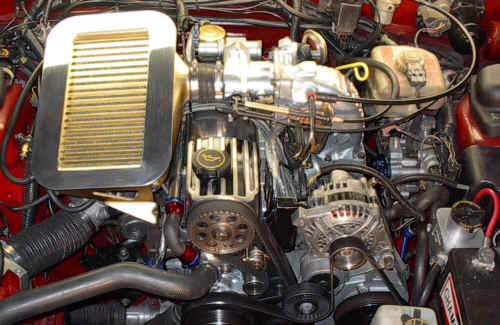
By: Russ Parker
Parts Needed
One turbo from an 87-88 Thunderbird Turbo Coupe. 87 & 88 were the only two years the T/C’s were intercooled. Intercooling is the process of running the very hot compressed air through a radiator like heat exchanger before it goes into the engine. Cooler air is denser air therefore rendering more energy. This is probably worth an extra 20HP which is nothing to sneeze at. It’s well worth it to use an intercooled turbo. The turbo on these is not a Garrett turbo it’s an IHI. It will only make 20psig of boost max but we’ll never take it that high without forged pistons will we?
(1) Manifold from the same car. The manifolds are still available from ford for $135.
(4) High impedance 36# injectors
(1) 190LPH Fuel pump
(1) Adjustable fuel pressure regulator
(1) Tachometer
(1) Boost Gauge
(1) Cyberdine air/fuel gauge
Hook the gauges up and get them working before you do the turbo swap. Especially learn to watch that air/fuel gauge. When the turbos installed and you see a lean condition happening it’s time to back out of the throttle.
Basically the turbo uses exhaust energy to spin a fan. That fan spins another fan via a shaft that compresses the air. Just like a centrifugal blower does but without a belt and at a lot higher speed. The compressed air travels through the intercooler where it is cooled then into the motor to be mixed with fuel then ignited. Adding this extra air without extra fuel leans out the mixture and lean is hot. Lean is so hot that it will make the charge go bang before it’s time. This is known as detonation (pinging) and it usually leaves a nice hole in your piston(s).
Installation of the turbo itself involves bolting on the manifold and turbo and running oil feed and return lines and coolant feed and return lines. I run my oil feed off of an auxiliary output on the sandwich adapter for my remote oil filters. Other guys hook up a T fitting between their oil pressure sending unit and run it from there. For the return line I put a fitting in my oil pan. Note: this fitting must be above the oil line or oil will back up into the turbo. For coolant in and out I tapped into the heater hoses. You’re really upping the volume of air with a turbo or blower and your stock fuel system was not designed to keep up with it. In order to make it work you must install a larger fuel pump and higher flow injectors. You need about 45psi of fuel pressure at idle, and 1 psi of pressure for every pound of boost. We’re using the stock waste gate setting here so 10psi of boost is all we should ever face. That is of course unless we’re insane and don’t care much for our weak cast pistons. 55 psi of fuel pressure is all we -should- ever need. I emphasize should because I know a lot of people will read about turning up the boost and decide to give it a try. Doing this without low compression forged pistons will make your stock cast pistons look like the back nine at Augusta.
There’s no kill like an overkill so I recommend using a 190 liter per hour fuel pump. I also like the T-rex inline fuel pump, that the blown mustang boys use, to help ease the burden on the in-tank pump. The blown mustang crowd is also where we turn for injectors on this swap. Get 36 lb. per hour injectors, use them on your stock ranger fuel rail. Also you need the adjustable fuel pressure regulator. You might wonder why I didn’t suggest getting the injectors off the TC that donated the turbo and manifold. Well they wont work with your stock EEC. You currently use high impedance (12-18ohm) injectors. The 2.3 Turbo cars use low impedance injectors.
After you have all this installed you’re about ready. You need to have a pipe fabbed up to run between the mass air meter and the turbo inlet, Have another pipe fabbed up to tie the turbo outlet to your exhaust, and find a good home for your o2 sensor while your at it. That’s it! Happy boosting and try and keep it in your own lane.
Big Time, Power Making Method:
Parts:
Block: m-6010-B230 Tall deck heavy duty turbo block. New from Ford. I’ve seen this priced as low as 350 bucks! Or substitute a 2.3 turbo from a Turbo Coupe, Merkur, or turbo Mustang.
Head:
Steel M-6049-A231 It’s a complete assembly. Comes with 1.89 intake and 1.59 exhaust valves, 62.4 cc combustion chambers and the springs and hardware. It even comes with a cam. It costs about $900 but in my opinion it’s worth it. By the time you have a stock D port head ported and machined for the larger valves and have the shrouds ground off you’ll have more than 900 and not have the cam.
Pistons:
You have a few choices here. TRW, Wiseco, JE, Mahle, etc. See what your machine shop can get you the best deal on, or shop around a bit. I’m using Wiseco cause my machine shop got them for me dirt cheap. I hear TRW is a better piston due to the dish being not quite so circular causing greater charge turbulence.
Rings:
I’ve heard a lot of turbo guys recommend using gapless rings. It does seem like a good idea as I have had my rings line up on a few occasions.
Rods:
Stock rods are plenty strong enough to handle this motor. That is until they start grinding material off of them for one reason or another. I use crower sportsman 5.5 rods. 5.5 is the stock length and they do have 5.7 available but we don’t want them for our turbo application.
Crank:
Use a stock crank. There are billet cranks out there for these motors but I don’t believe you need one on a motor that wont be seeing 10,000 RPMs. You can also get a 2.5 crank to swap in but I’m not sure how this worked or if it offers any advantage. My 2.5 crank is still a paperweight on my desk.
Oil Pump:
I’m using a high volume sealed power pump and it seems to be working fine.
Head Gasket:
Fel-Pro is the way to go……I have a McCord gasket but I’ve heard I boned up by using it. Oh well I’ll run it until she blows.
O-Ringing:
Some guys say yes. get it O-ringed. I’m still up in the air over this. It isn’t a horsepower issue it’s a durability issue. I feel the worst case scenario without O-rings is blowing a head gasket. Not that big of a deal really, it’s a lot cheaper than having it blow something else. If I have to have a weak link to act as a fuse I’d rather it be the gasket.
Header:
The manifolds seem fine. I have one that’s nicely jet hot coated and it’s real spiffy. It doesn’t say “Hey I’m going to kick your wimpy ass” like the stainless ATR header though. This thing is sweet looking! It’s pricey but sweeeet! It will help out in the turbo lag department.
Turbo:
We’re not looking for just a runner we’re looking to kick ass here. We want a serious boost making turbo so Garret is the way to fly. T-03 is good, T04 is better. I actually have a T-56 but I’m too chicken to try it. Shop around check with Turbo City and Turbonetics and see who has the best deals.
Intercooler:
We’re not building race cars here, so a water cooled IC is a bit extreme. We do want some power so we want a decent air to air IC. A front mounted IC from a diesel F-350 is real nice. They mount up in front of the Radiator. Personally I’m just using the IC from a 88 turbo coupe, and force feeding air to it through my hood scoop.
Other Stuff:
You’ll need the EEC, fuel injectors, intakes, distributor, throttle body, vane meter, hell the whole harness and all it’s goodys off of an intercooled turbo coupe. Its important that its an intercooled car because the fuel maps and stuff are different.
You’ll also need the gauges mentioned in the first method. To put more than the 10psi that the stock waste gate actuator will allow you’ll have to swap in a bleeder valve. The looser you have the valve the more boost the turbo will have to make to overcome it. Be careful not to crank it too high. Remember it’s a new motor so treat it nice for a while.
Mods to this motor should come later. Learn to drive with the turbo, how it acts, etc. before you go modding it too heavily.
Mods Include:
swapping in larger throttle body
tweaking the vane meter
more boost
bigger injectors
exhaust tuning
superchip
etc.
The simplest way to start boosting is to just swap in an entire turbo motor and all it’s electronics from a turbo car. Then start building from there.
Jim Oaks is the founder of TheRangerStation.com, the longest-running Ford Ranger resource online since 1999. With over 25 years of hands-on experience building and modifying Ford Rangers — including magazine-featured builds like Project Transformer — Jim has become one of the most trusted authorities in the Ford Ranger off-road and enthusiast space. In 2019, he was loaned a Ranger FX4 by Ford Motor Company to test and document across the TransAmerica Trail. Jim continues to inspire and guide Ranger owners around the world.
